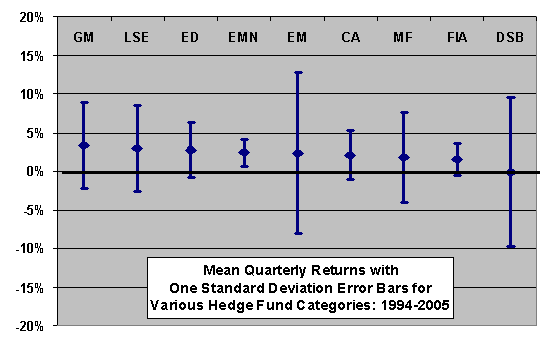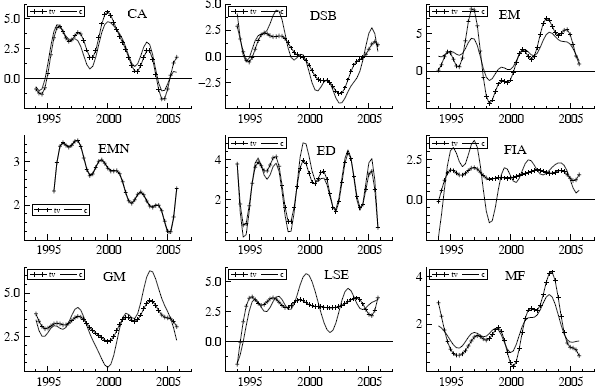Has dramatic growth and proliferation of hedge funds used up all the alpha, or do opportunities for excess returns still abound? In their October 2006 paper entitled “Net Inflows and Time-Varying Alphas: The Case of Hedge Funds”, Andrea Beltratti and Claudio Morana investigate whether dramatic asset growth has eroded the performance of hedge fund managers. Their analysis encompasses the following categories of hedge funds: convertible arbitrage (CA – 8%), dedicated short bias (DSB – 1%), emerging markets (EM – 4%), equity market neutral (EMN – 7%), event driven (ED – 17%), fixed income arbitrage (FIA – 7%), global macro (GM – 11%), long/short equity (LSE – 32%), managed futures (MF – 5%). The percentages indicate the share of total hedge fund assets by category as of December 2005. Using quarterly fund net returns and asset flows and appropriate return benchmarks for each fund category over the period 1994-2005, they conclude that:
- There is a positive correlation between past returns and future flows. Good (bad) past returns attract (repel) funds.
- Excess returns correlate negatively with past flows mainly for the arbitrage oriented strategies. Only for event driven (ED) funds is the effect strong.
- There is no general decline in the excess returns produced by the hedge fund industry. The growing supply of hedge fund capital has not exhausted the set of opportunities available from noise traders and investors with heterogeneous time horizons and objectives.
The following chart, constructed from data in the paper, shows the mean quarterly returns during 1994-2005 (with one standard deviation error bars) for the nine categories of hedge funds. The categories are in order of decreasing mean returns. Eight of the nine categories have positive mean quarterly returns. The standard deviations of returns are especially large for emerging markets (EM) and dedicated short bias (DSB) funds.

The following set of charts, taken from the paper, shows the behavior of aggregate alpha over time for the nine fund categories using both constant (c) and the time-varying (tv) benchmarking methods. Note that the alphas are not always positive and that most fund categories show no alpha trend, although the performance of equity market neutral (EMN) hedge funds suggests prolonged decline.

In summary, it seems that hedge funds overall are not exhausting the supply of alpha offered by other players in worldwide equity markets.